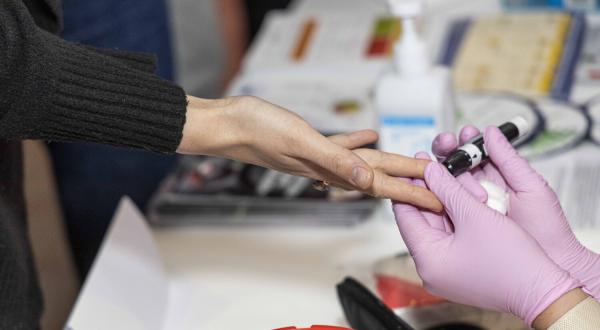.
RSU Professor and Infectologist Ludmila Vīksna on What Is Currently Known About COVID-19 (Continued)
For Students
For RSU Employees
Crisis
The terminology
Infected with SARS-CoV-2 - a person who is infected with the virus.
Sick with COVID-19 - a person/patient who has been infected with SARS-CoV-2 and has symptoms of the disease.
The factors, facts, probabilities and the prognoses at my disposal
- Being infected1 poses a greater risk to people around you than being sick, because
- infected people are unaware of the risk they pose to others;
- others do not avoid infected people because they are not aware of the risk they pose;
- being sick makes people less mobile because they don’t feel well and they self-isolate to a higher degree;
- being aware of someone’s disease makes others’ behaviour more cautious.
- It is currently not possible to completely stop the spread of the virus2, because
- everyone is breathing;
- the virus enters the environment and infects the next person;
- most people have not been exposed to the virus and therefore have not developed specific antibodies to inhibit the viability of the virus, including its reproduction;
- there is still no vaccine to produce specific antibodies, thus preventing the spread of the virus.
- Treatments
- There is still no etiologic medication for treating COVID-19, but dozens have been reported as “candidates”, including those successfully used to treat other diseases such as malaria (chloroquine, hydroxychloroquine), viral hepatitis and HIV infections (for example, darunavir), or the Ebola virus (remdesivir). Among the medication currently being studied, the Japanese medication Avigans seems to be the most effective. Veterinary medications are being approved. It has been reported that several medications are already being tested on small numbers of people (70 - 100 patients) and in some cases the results are promising.
- A method for treating infectious diseases that has been used since the previous century and that is now being revived is to administer plasma from recovered patients to sick patients. This plasma contains specific antibodies and can slow down the progression of the disease. Several countries have reported individual successful cases from using this method. The method requires more research and assessment.
- Vaccines
- There is still no vaccine against COVID-19 (SARS-CoV-2). Several countries (China, France, Germany, Russia, the USA, etc.) report that specialists are working intensively on developing vaccines. Clinical trials on humans are already underway;
- The pneumococcal vaccine is useful. It is targeted towards Streptococcus pneumoniae, or pneumococci, which often cause severe or even fatal lung disease in humans, especially people 65 years or older. A person is particularly susceptible to pneumococcal infection if they have the flu, other ARVI and most likely COVID-19 as well. The vaccine is recommended to protect COVID-19 patients from the onset of secondary infections. There is a pneumococcal vaccine available in Latvia that only needs to be administered once in a lifetime to ensure immunity. Latvijā ir pieejama tāda pneimokokālā vakcīna, kas ievadāma tikai vienu reizi mūžā, lai nodrošinātu imunitāti.
- In the context of COVID-19, the BCG (Bacillus Calmette-Guérin) vaccine is a vaccine that has produced a particular non-specific immunity that may protect humans from the disease in general and from severe forms of COVID-19 if they were vaccinated in childhood. The reason for this assumption is the observation that in countries where the population has been vaccinated with BCG there are fewer cases and deaths than in other countries where this vaccine is not used. There are currently no scientifically substantiated facts in favour of this assumption, but the issue is being researched.
- Clinical overview
- The symptoms COVID-19 patients experience are similar to those of the flu, but in addition to those, about one third of patients also develop anosmia, or loss of smell, that develops before the onset of symptoms affecting the lungs. There is often severe rhinitis, which is not typical to flu, coughing fits, and severe heaviness in the chest.
- The significance of specific laboratory tests for detecting viruses and antibodies in the context of COVID-19:
- detecting the virus is necessary to find out if a person is infected;
- detecting specific antibodies which work against SARS-CoV-2 indicates that the person has been infected with the virus, or is sick with COVID-19, but does not mean that the virus is no longer present.
- IgM antibodies that first appear after about 7 to 10 days are detectable. It is not known for how long the IgM antibodies last, but possibly for one month. Unfortunately, the current methods for determining IgM allow for many false positives and false negatives. IgG antibodies appear later - after about a month. It is not known for how long IgG antibodies last - it could be a few months, but maybe years. The latter option would be good news, because then people would no longer get sick.
- Who is not at risk of SARS-CoV-2?
- In the current circumstances people for whom the following two conditions apply are practically not at risk:
- they have recovered from,or are infected with SARS-CoV-2;
- they have developed specific long-lasting antibodies.
- If these two conditions are met and the virus can no longer bet detected, the person no longer poses a risk to others.
- Is it important to detect the presence of the virus in healthy people?
- It is important to perform tests for SARS-CoV-2 for epidemiological purposes to determine the nature and prevalence of the infectious agent.
- It is not important if the person shows no symptoms (because such people do not need treatment) and there is no epidemiological need.
- What is the prognosis for how the pandemic will develop?
- It is still too early to make a prognosis, even based on the figures we currently have at our disposal and the developments and experience of other countries. This is because of the differences in the measurable characteristics of pandemics in different countries, the extreme differences countries’ approach to the epidemiological precautionary measures and the fact that not all countries are conducting epidemiological surveillance.
Maybe the pandemic in Asia, Europe and North America will diminish over the next 1.5 to 2 months but will remain in the form of isolated cases. Epidemics can reoccur in a similar way to the flu.
_________
1 The term infected is used to refer to a person infected by SARS-CoV-2, but who is healthy, i.e., a person who has no symptoms.
2 T he word here virus refers to SARS-CoV-2.
Ja rodas būtiski jautājumi, lūdzu, rakstiet man e-pastā!
Prof. Dr. habil. med. Ludmila Vīksna
Head of Department, Department of Infectology
Academic Staff, Department of Infectology
Chair of Convent of Councillors
Academic Staff, Department of Infectology
Chair of Convent of Councillors
Riga East University Hospital, Latvian Centre of Infectious Diseases
3 Linezera iela, Riga
The first part of the article (16 March 2020)
Related news
 RSU Health Day attracts many first-time donors and large number of student research groupsFor RSU Employees, For Students
RSU Health Day attracts many first-time donors and large number of student research groupsFor RSU Employees, For Students



